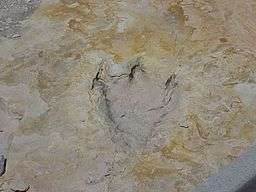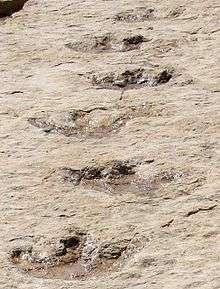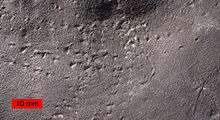Trackway


A trackway is an ancient route of travel for people or animals. In biology, a trackway can be a set of impressions in the soft earth, usually a set of footprints, left by an animal. A fossil trackway is the fossilized imprint of a trackway, a type of trace fossil. Trackways have been found all over the world. They are especially valuable for determining some characteristics of life-forms, such as behavior. Thus some trackways for hominids in Africa showed that they lived together and were not solitary. The study of trackways is an aspect of ichnology, the study of marks left by living organisms. Since identifying the makers of trackways has not ordinarily proved possible, trackway-makers are given the conventional genus name Ichniotherium, "marking creature".
A possible first connection of a trackway with the vertebrate that left it was published by Drs. Sebastian Voigt and David Berman and Amy Henrici in the 12 September 2007 issue of Journal of Vertebrate Paleontology. The paleontologists who made the connection were aided by unusually detailed trackways left in fine-grained Lower Permian mud of the Tambach Formation in central Germany, together with exceptionally complete fossilised skeletons in the same 290-million-year-old strata. They matched the two most common trackways with the two most common fossils, two reptile-like herbivores known as Diadectes absitus (with the trackway pseudonym Ichniotherium cottae) and Orobates pabsti (with the trackway pseudonym of Orobates pabsti).[2]
Example trackways
- Mammoth, White Sands National Monument. Near Alamogordo, New Mexico
- Dinosaur tracks, near Moab, Utah[3]
- Dinosaur Valley State Park, Glen Rose Formation, Texas
- Valley of the Dinosaurs, Paraíba, Brazil
- Prehistoric Trackways National Monument near Las Cruces, New Mexico
Example ancient military trackways or drovers' roads
See also
Notes
- ↑ Schulp, Anne S.; Al-Wosabi, Mohammed; Stevens, Nancy J.; Stepanova, Anna (2008). "First Dinosaur Tracks from the Arabian Peninsula". PLoS ONE. 3 (5): e2243. Bibcode:2008PLoSO...3.2243S. PMC 2373924
 . PMID 18493306. doi:10.1371/journal.pone.0002243.
. PMID 18493306. doi:10.1371/journal.pone.0002243. - ↑ Science Daily, "Who Went There? Matching Fossil Tracks With Their Makers", 15 September 2007.
- ↑ Area with 200-plus dinosaur tracks opening to public soon accessdate=2014-08-25
